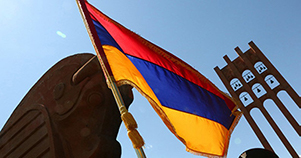28.05.2024

Spring had arrived... that night I attended Mrs. Lucia's child’s birthday party. There was obvious commotion in the house. I kissed grandma’s hand and congratulated her grandson on his birthday. He said that his birthday had passed long ago and didn't know why they were making extra expense.
They had set a beautifully table and, later that night, three well-dressed young men and two young ladies arrived and took the seats of honour. Ms. Lucia closed the courtyard door and said, “Now we can talk freely, Artashes is ours and, though he is young, we trust his discretion…”
One of the young men stood up and excitedly said,
"I have some very surprising and happy news that I must tell you without any further ado. Armenians in Armenia HAVE ESTABLISHED AN INDEPENDENT GOVERNMENT. NOW WE HAVE TOO HAVE OUR FLAG ALONGSIDE THOSE OF THE FREE NATIONS."
A wave of excitement filled the hearts and souls of those at the table and old grandma would have fallen from her chair without uttering a word, if the others had not caught her immediately... Finally, grandma broke the silence and asked, "Son, who is the king? Is it Andranik Pasha?"
The gentleman giving the message explained that the existence of the Armenian Republic was a fact, but it was not known who the leader was ... Grandma declared that since we now have a flag, we would have a king one day.
If it wasn’t for Ms. Lucia's presence, I might have thought it was all a lie, because there were no Armenians left in the world. If you don't believe that, go and roam the Shedadia and Hasich deserts, where unburied bones mourn the death of Armenians... I think the young people mentioned earlier were working as translators for the Germans and had met Mrs. Lucia before.
The next day I went to work early, but couldn't accept the idea how, since all Armenians were destroyed, an independent Armenian government could exist without Armenians. I couldn't believe it.
This translation retains the original Armenian language style as far as possible.
Excerpt from the memoir titled "Hushapatum: an Armenian from Zeytun’s odyssey, 1908-1921" by Artashes Poghosian, an Armenian Genocide survivor.
Dr. Narine Margaryan
Head of the Armenian Genocide Source Studies Department and Academic Secretary, Armenian Genocide Museum-Institute





